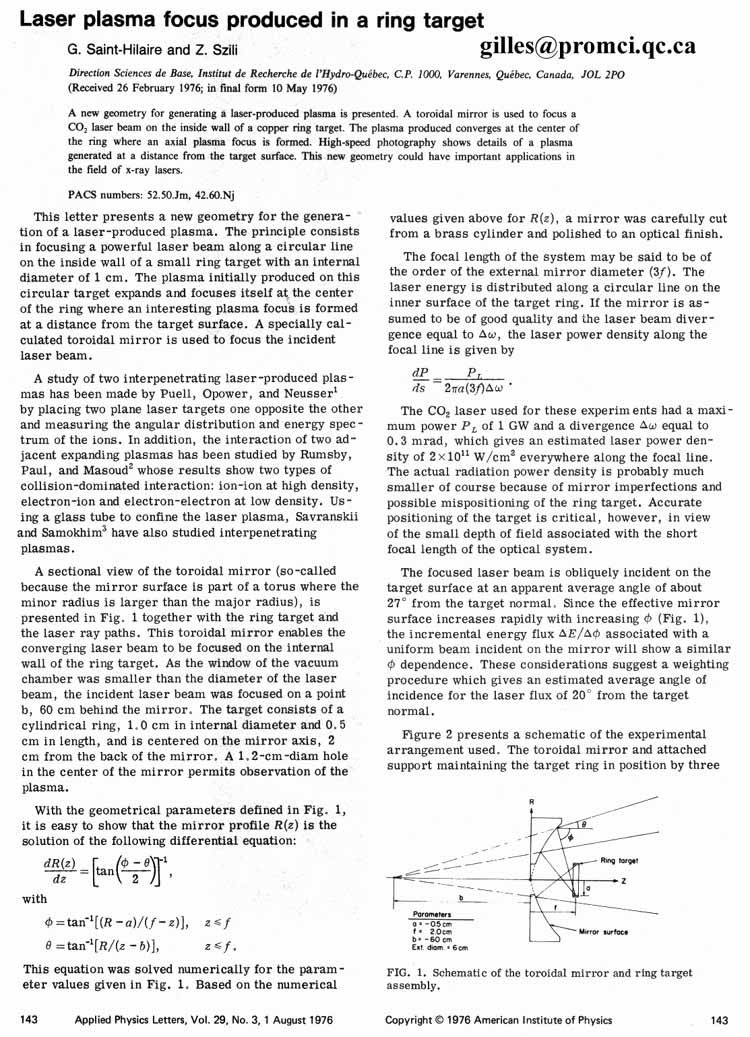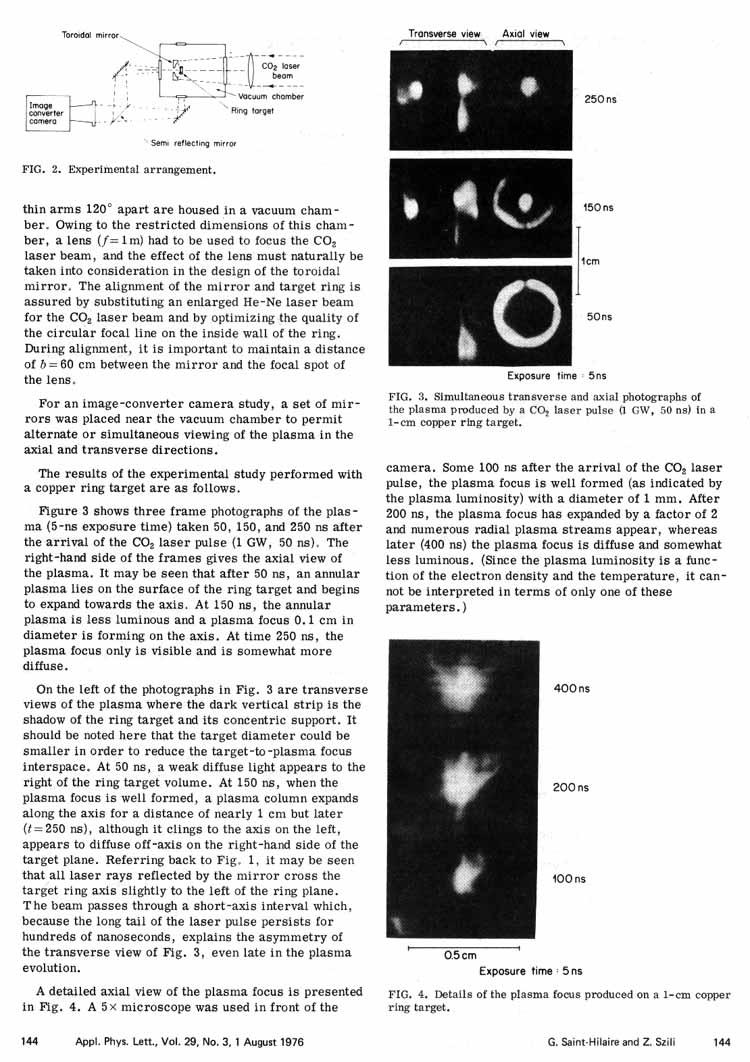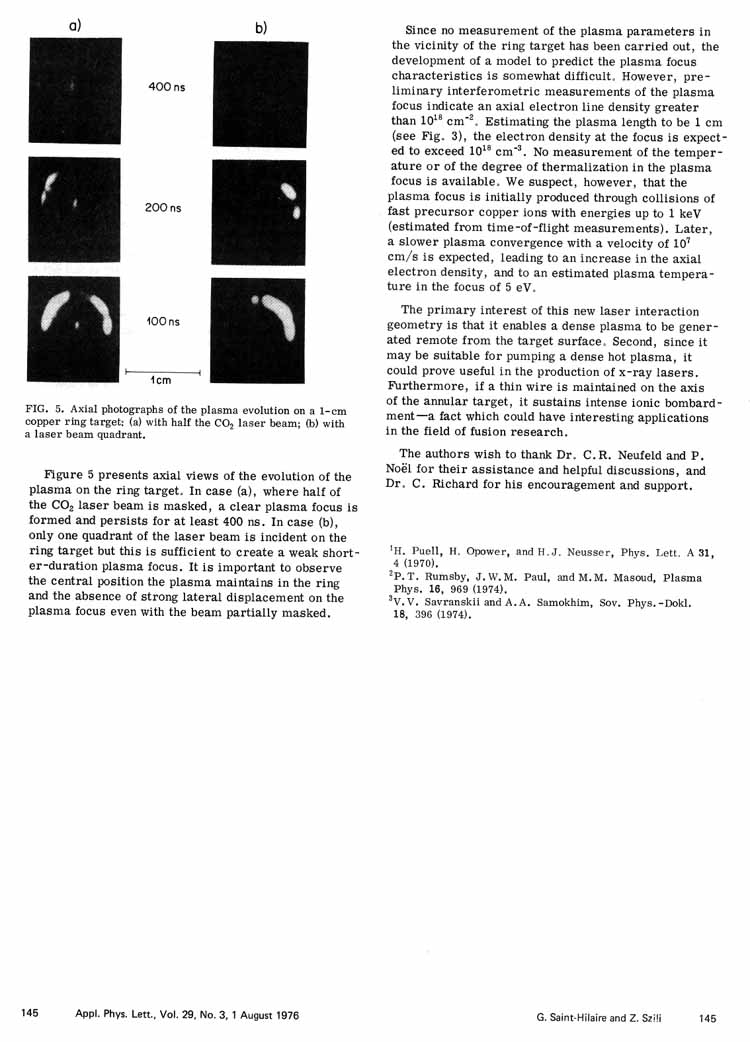
FUSION NEUTRONS PRODUCED BY SONOLUMINESCENCE (SONOFUSION)
March 2002
Following the press debate on "Evidence for Nuclear Emissions During Acoustic Cavitation" (bubble
fusion neutron)
by Rusi Taleyarkhan from Oak Ridge, Fred Becchetti from the University of Michigan
and Robert Nigmatulin of the Russian Academy of Sciences, published in
http://www.sciencemag.org/feature/data/hottopics/bubble/index.shtml
May be one should also look at a somewhat similar phenomenon in a:
Saint-Hilaire Laser Ring Target -
A Bi-Dimensional Particle Flow Convergence (leading to fusion?)
(Laser plasma focus)
http://www.promci.qc.ca/Saint-HilaireLaserRingTarget.htm
Convergent geometries are the most promising for extreme
matter
condition,
In an attempt to reach nuclear fusion density and temperature,
plasma physicists are using lasers to produce shockwaves on the external surface
of micro-particle.
Attention is then given to what is happening within this micro-particle 3D convergent geometry.
However, when a laser beam hit a solid surface, matter is extracted
and rapidly accelerated.
The present comment is to suggests a careful attention on the 2D convergent geometry of
a ring target,
making this extracted matter to collide convergently on itself.
In a preliminary experiment conducted in 1975, and published
in
American Institute of Physics
- http://ojps.aip.org/aplo Applied Physics Letters
Vol. 29, No. 3, 1 August 1976,
an exceptional radiative interaction has been reported.
It is too early to confirm fusion potential, but this research should eventually be continued forward...
Comparison between Cavitation Bubble and Laser Ring Target
- In Laser Ring Target, the particle flow is mainly radially, with little momentum in the axial direction.
Pressure leak on the axis will required a momentum transfer in that direction through interactions,
which may well occur to late for fusion consideration anyway?
- The notion of pressure is associated with a thermalized gas and not with a particle
beam.
For this reason, it does not apply in the transient period where the beam implodes on itself,
but "pressure lost" apply only later during plasma accumulation and thermalization.
The first particle front is the interesting period (at least for fusion), not the
late plasma thermalization.
- Laser Ring Target open the door for fusion plasma
not completely in the thermal state. A very interesting consideration..
- If one look carefully to the Laser Ring Target geometry, you will notice that all the radiation
become concentrated on the axis in the forward area. By making the ring slightly taper,
it can be made to direct the matter into this radiation area for post heating by
multi laser pulses.
(interesting also for non fusion plasma generator).
- Cavitation bubble vacuum or internal pressure is not
easy to control,
while the Laser Ring Targer pressure chamber can be externally controlled.
- Cavitation bubble involve little overall energy,
while Laser Ring Target could involve much more matter, and a lot more interactions per cycle.
- Cavitation bubble will not be easy to scale up (unless multi-bubbles are
produced),
while Laser Ring Target is eventually easily scalable.
- The Ring Target can be made of a cooled circular support
in which a flat target strip can be continuously pull-in around and out.
- Notice that in the Ring Target geometry,
the focal point is replaced by a focal line around the inside of the ring
target.
- The Laser Ring Target geometry further concentrate all the radiation on the axis in the forward
area.
By making the ring slightly taper, one can direct the matter into this radiation area for post heating by
multi laser pulses.
(mostly interesting for non-fusion plasma generator).
* * * * *
The following is a publication of the
American Institute of Physics
Applied Physics Letters http://ojps.aip.org/aplo
Since issues before 1985 are not yet online,
we have exceptionally made a temporary copy on this private page.



Some newsgroup comments
*******************************************
March 13th, 2002
> May be one should also look at a somewhat similar phenomenon
> in a Laser Ring Target
***{When a cavitation bubble collapses, brief but enormous central
pressures result, due to the sudden stoppage of the moving masses when
they slam together at the center and, importantly, due to the fact that
there is no open path of lesser resistance by which the pressures may be
bled off. In your experiment, as described at
http://www.promci.qc.ca/Saint-HilaireLaserRingTarget.htm, things are
different: while the masses of the accelerated Cu ions do slam together in
the center after being blasted off of the surface of the copper ring by
the CO2 laser, their confinement when they slam together in the center is
two-dimensional only. There are many open paths of lesser resistance above
and below the plane of convergence, which can bleed off the pressure,
thereby preventing it from rising to the levels that may be available at
the center of a collapsing cavitation bubble. Thus your method, while
interesting, does not strike me as a very promising way to achieve the
pressures needed for fusion.
By the way: a problem with your design is likely to be the pitting of the
interior surface of the copper ring, which will degrade the tightness of
the plasma focus at the center--rather rapidly, I suspect. That means you
would be constantly having to turn the thing off and replace the rings, a
circumstances that would render the device completely unsuitable for any
sort of long-term operation, even if were proven to be capable of
producing fusion, unless it were first to be redesigned to permit rapid
replacement of the rings. (Here's an idea to that end: feed a series of
fresh rings into the thing from the top, perhaps glued to the surface of a
motion picture film, with each new ring briefly stopping, being hit by the
laser, then shifting forward step by step, until it finally exits out the
bottom. That might work! :-) }***
Mitchell Jones mjones@jump.net
*******************************************
March 13th, 2002Bonjour Mitchell, Merci pour votre commentaire.
Please, let me point out the following:
- The particle flow is mainly radially, with little momentum in the axial direction.
Pressure leak on the axis will required a momentum transfer in that direction through interactions,
which may well occur to late for fusion consideration anyway?
- Laser ring target open the door for fusion plasma not completely in the thermal state. Very interesting.
- If you look carefully to the Laser ring target geometry, you will notice that all the radiation
is concentrated on the axis in the forward area, which, by making the ring slightly taper,
can be made to direct the matter into this radiation area for post heating by multi laser pulses.
(interesting also for non fusion plasma generator).
- Cavitation bubble involve little overall energy,
while Laser ring target could involve much more matter, and a lot more interactions per cycle.
- Cavitation bubble will not be easy to scale up, while laser ring target is eventually scalable.
- The ring target can be made of a cooled circular support
in which a flat target strip could be continuously pull-in around and out.
Hope theses comments will suggest you still a better experiment design?
Meilleures salutations, Gilles http://quasiturbine.promci.qc.ca
*******************************************
March 13th, 2002Q1- what is the connection?
Q2- what is the significance expected from such a research?
Q3- what do you expect from a mirror
with a focal point else than convergence of light waves?
Expensive toys are usually fascinating, yet the player could extract a
new way to play, hence I ask, what is new?
EL hemetis@hotmail.com
*******************************************
March 13th, 2002
> - The particle flow is mainly radially,
> with little momentum in the axial direction.
> Pressure leak on the axis will require
> a momentum transfer in that direction through interactions,
> which may well occur to late for fusion consideration anyway?
***{True, but that was precisely my point: you are counting on head-on
collisions between positive ions to be energetic enough to overcome the
Coulomb barrier. When a cavitation bubble collapses, however, the
particles coming together in the center do not merely count on their own
energy, but also on that which will be supplied by the particles crashing
in on top of them from all sides. The result is a brief pressure spike
that goes vastly higher than would be the case if the particles at the
center had a low pressure escape route by which they could exit the
situation. That's why I strongly doubt that it will be possible for you to
produce fusion in this way. --MJ}***
> - Laser ring target open the door for fusion plasma
> not completely in the thermal state. Very interesting consideration.
>
> - If you look carefully to the Laser ring target geometry,
> you will notice that all the radiation
> is concentrated on the axis in the forward area,
> which, by making the ring slightly taper,
> can be made to direct the matter
> into this radiation area for post heating.
> (interesting also for non fusion plasma générator).
>
> - Cavitation bubble involve little overall energy,
> while Laser ring target could involve much more matter, and a lot more interactions per cycle.
***{I agree that the idea is worth a close look, but I see the
two-dimensional confinement as a very bad weakness. You can't give a
high-pressure plasma a low-pressure escape route and expect that it will
not take it; and when it does, you give up the energy contributions of the
additional particles that are coming up from behind. --MJ}***
> - Cavitation bubble will not be easy to scale up
***{It may not be easy (or even desirable) to increase the size of the
bubbles, but if each bubble is a net source of energy to the fluid due to
fusion, then the rate of energy production will be a function of the
number of bubbles produced--which means: you would scale such a system up
by increasing the number of bubbles. (Not easy, perhaps, but if a lot of
people turn their attention to these problems, I would expect to see rapid
progress. --MJ}***
> while laser ring target is eventually scalable.
> - The ring target can be made of a cooled circular support
> in which a flat target strip could be continuously pull-in around and out.
***{That's a good idea, but foil is notoriously prone to wrinkling, and
would be a bitch to keep in the proper shape. Maybe the same idea would
work if you were to feed a length of copper wire off of a spool into a
circular form and let it function as the ring. There would be a gap where
the wires overlapped, but that would probably degrade the plasma less than
the pitting which would result from using a fixed ring. That approach
would avoid the obvious drawback of my "motion-picture film" idea--to wit:
that each new ring would disrupt the plasma as it moved into place. By
such means, the maintenance of a continuous plasma should be possible.
--MJ}***
> Hope theses comments will suggest you still a better experiment design?
***{Here's another thought: use deuterium-loaded Pd wire. It might de-load
due to bending while being drawn into the shape of a ring, but if not I
would expect a lot of deuterons to come crashing together at the center of
the ring, as soon as you fired up your laser. That should give you some
real prospects of attaining fusion, assuming you can get the energies high
enough to overcome the Coulomb barrier. Do you still have access to the
apparatus you used in your experiment? If so, consider using a Pd ring
rather than a Cu ring, and load it before zapping it in the apparatus.
(Hey, what can it hurt? :-) --MJ}***Mitchell Jones mjones@jump.net
*******************************************
March 14, 2002***{Here's another thought: use deuterium-loaded Pd wire. It might de-load
> due to bending while being drawn into the shape of a ring, but if not I
> would expect a lot of deuterons to come crashing together at the center of
> the ring, as soon as you fired up your laser. That should give you some
> real prospects of attaining fusion, assuming you can get the energies high
> enough to overcome the Coulomb barrier. Do you still have access to the
> apparatus you used in your experiment? If so, consider using a Pd ring
> rather than a Cu ring, and load it before zapping it in the apparatus.
> (Hey, what can it hurt? :-) --MJ}***
According to some reports of experiences in the decade of the 30 in
Copenhagen area, it hurts :-)Alejandro Rivero rivero@sol.unizar.es
*******************************************
March 14, 2002As you know, the notion of pressure is associated
with a thermalized gas and not with a particle beam,
and for this reason it does not apply in the transient period
where the beam implodes on itself,
but only later during plasma thermalization.
I count on that to define an interesting period
associated with the first particle front,
not with the later plasma accumulation (at least for fusion).
Furthermore, this first front implosion is convergent,
and much of the result will depend of the effective diameter.
My opinion is that no one has a definitive answer on that yet?
I like very much the Cavitation bubble geométry,
and do not suggest a superior 2D set-up,
but only a different approach with a potential still to verify?
In Science, nothing is perfect, except nature!
My experiment has been carry out in 1975,
much before the PC-XT was available!
At that time, I was leading experiments on a theta-pinch machine,
and my Laser Ring Target was far off the main stream.
In fact, this experiment has never been officially approved
by my lab (fortunately, they approved the paper out!).
All apparatus have been since dismantle,
otherwise, I would retry to interest the lab
and run again using a deuterium-loaded Pd ring.
Meilleures salutations, Gilles http://quasiturbine.promci.qc.ca
*******************************************
March 14, 2002> As you know, the notion of pressure is associated
> with a thermalized gas and not with a particle beam,
> and for this reason does not apply in the transient period
> where the beam implodes on itself,
> but only later during plasma thermalization.
> I count on that to define an interesting period
> associated with the first particle front,
> not with the later plasma accumulation (at least for fusion).
> Furthermore, this first front implosion is convergent,
> and much of the result will depend of the effective diameter.
> My opinion is that no one has a definitive answer on that yet?
***{I agree. --MJ}***
> I like very much the Cavitation bubble geométry,
> and do not suggest a superior 2D set-up,
> but only a different approach with a potential still to verify?
***{Yes, it merits a close look, especially if you modify the setup so
that the first implosion front consists of deuterons. --MJ}***
> In Science, nothing is perfect, except nature!
> My experiment has been carry out in 1975,
> much before the PC-XT was available!
> At that time, I was leading experiments on a theta-pinch machine,
> and my Laser Ring Target was far off the main stream.
> In fact, this experiment has never been officially approved
> by my lab (fortunately, they approved the paper out!).
> All apparatus have been since dismantled.
***{That's too bad. I was hoping that you had taken the apparatus home and
stored it in your basement. :-) --MJ}***
> otherwise, I would retry to interest the lab
> and run again using a deuterium-loaded Pd ring.
***{Now that you have posted your paper on the net, perhaps someone will
follow up on your approach. Given the present surge of interest in the
topic, I would say that the chances are good. --MJ}***
Mitchell Jones mjones@jump.net
*******************************************
March 14, 2002> ***{Now that you have posted your paper on the net,
> perhaps someone will follow up on your approach.
> Given the present surge of interest in the
> topic, I would say that the chances are good. --MJ}***
I would like very much...
but I do not know however, if my lab would think the same?
Our lab had impressive resources at that time,
but as I told you, this project has never interested
any of my superiors or colleagues and was done essentially off hours.
Because we had no specific budget,
we had to adapt a old vacuum chamber,
too small for a full size laser beam window.
This is the reason we had to use a lens,
which has complicated the calculation of the special mirror.
It is funny for me to remember that this mirror
was officially referred to as a big washer,
to make its way safely though the machine shop paper work!
I also remembers the couple weekends I spent polishing it.
Done with today technology, and reasonable means,
the result would be most interesting to me,
and hopefully to others...
If some one need a powerful flashing lamp,
that is certainly a way to go...
Salutations, Gilles http://quasiturbine.promci.qc.ca
>>My experiment has been carry out in 1975,
>>much before the PC-XT was available!
>>At that time, I was leading experiments on a theta-pinch machine,
>>and my Laser Ring Target was far off the main stream.
>>In fact, this experiment has never been officially approved
>>by my lab (fortunately, they approved the paper out!).
>>All apparatus have been since dismantle
>>otherwise, I would retry to interest the lab
>>and run again using a deuterium-loaded Pd ring.
*******************************************
March 15, 2002I am wondering how this would relate to the production of potential
collimated high energy / high frequency devices, i.e. x-ray laser type or maser type device,
and what happens in the experiment in the 3d sense, is the copper 2d,
what happens if the copper is a ball that is the diameter of the wavelength of light?Tim Davis daviest@shaw.ca
**************************************************************************************
*******************************************
*******************************************
*******************************************
*******************************************